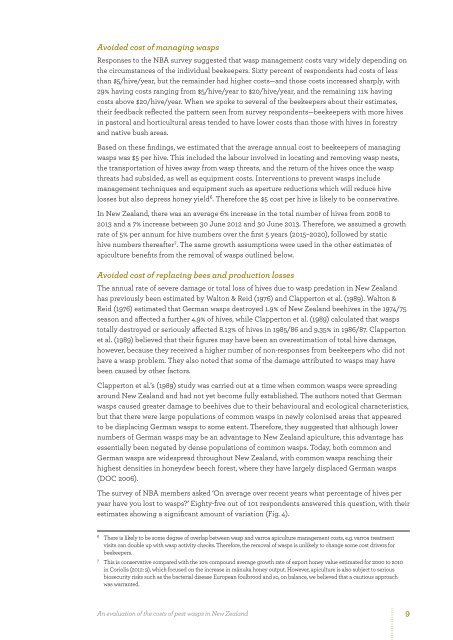evaluation-pest-wasps-nz
evaluation-pest-wasps-nz
evaluation-pest-wasps-nz
You also want an ePaper? Increase the reach of your titles
YUMPU automatically turns print PDFs into web optimized ePapers that Google loves.
Avoided cost of managing <strong>wasps</strong>Responses to the NBA survey suggested that wasp management costs vary widely depending onthe circumstances of the individual beekeepers. Sixty percent of respondents had costs of lessthan $5/hive/year, but the remainder had higher costs—and those costs increased sharply, with29% having costs ranging from $5/hive/year to $20/hive/year, and the remaining 11% havingcosts above $20/hive/year. When we spoke to several of the beekeepers about their estimates,their feedback reflected the pattern seen from survey respondents—beekeepers with more hivesin pastoral and horticultural areas tended to have lower costs than those with hives in forestryand native bush areas.Based on these findings, we estimated that the average annual cost to beekeepers of managing<strong>wasps</strong> was $5 per hive. This included the labour involved in locating and removing wasp nests,the transportation of hives away from wasp threats, and the return of the hives once the waspthreats had subsided, as well as equipment costs. Interventions to prevent <strong>wasps</strong> includemanagement techniques and equipment such as aperture reductions which will reduce hivelosses but also depress honey yield 6 . Therefore the $5 cost per hive is likely to be conservative.In New Zealand, there was an average 6% increase in the total number of hives from 2008 to2013 and a 7% increase between 30 June 2012 and 30 June 2013. Therefore, we assumed a growthrate of 5% per annum for hive numbers over the first 5 years (2015–2020), followed by statichive numbers thereafter 7 . The same growth assumptions were used in the other estimates ofapiculture benefits from the removal of <strong>wasps</strong> outlined below.Avoided cost of replacing bees and production lossesThe annual rate of severe damage or total loss of hives due to wasp predation in New Zealandhas previously been estimated by Walton & Reid (1976) and Clapperton et al. (1989). Walton &Reid (1976) estimated that German <strong>wasps</strong> destroyed 1.9% of New Zealand beehives in the 1974/75season and affected a further 4.9% of hives, while Clapperton et al. (1989) calculated that <strong>wasps</strong>totally destroyed or seriously affected 8.13% of hives in 1985/86 and 9.35% in 1986/87. Clappertonet al. (1989) believed that their figures may have been an overestimation of total hive damage,however, because they received a higher number of non-responses from beekeepers who did nothave a wasp problem. They also noted that some of the damage attributed to <strong>wasps</strong> may havebeen caused by other factors.Clapperton et al.’s (1989) study was carried out at a time when common <strong>wasps</strong> were spreadingaround New Zealand and had not yet become fully established. The authors noted that German<strong>wasps</strong> caused greater damage to beehives due to their behavioural and ecological characteristics,but that there were large populations of common <strong>wasps</strong> in newly colonised areas that appearedto be displacing German <strong>wasps</strong> to some extent. Therefore, they suggested that although lowernumbers of German <strong>wasps</strong> may be an advantage to New Zealand apiculture, this advantage hasessentially been negated by dense populations of common <strong>wasps</strong>. Today, both common andGerman <strong>wasps</strong> are widespread throughout New Zealand, with common <strong>wasps</strong> reaching theirhighest densities in honeydew beech forest, where they have largely displaced German <strong>wasps</strong>(DOC 2006).The survey of NBA members asked ‘On average over recent years what percentage of hives peryear have you lost to <strong>wasps</strong>?’ Eighty-five out of 101 respondents answered this question, with theirestimates showing a significant amount of variation (Fig. 4).6There is likely to be some degree of overlap between wasp and varroa apiculture management costs, e.g. varroa treatmentvisits can double up with wasp activity checks. Therefore, the removal of <strong>wasps</strong> is unlikely to change some cost drivers forbeekeepers.7This is conservative compared with the 10% compound average growth rate of export honey value estimated for 2000 to 2010in Coriolis (2012: 9), which focused on the increase in mānuka honey output. However, apiculture is also subject to seriousbiosecurity risks such as the bacterial disease European foulbrood and so, on balance, we believed that a cautious approachwas warranted.An <strong>evaluation</strong> of the costs of <strong>pest</strong> <strong>wasps</strong> in New Zealand9


